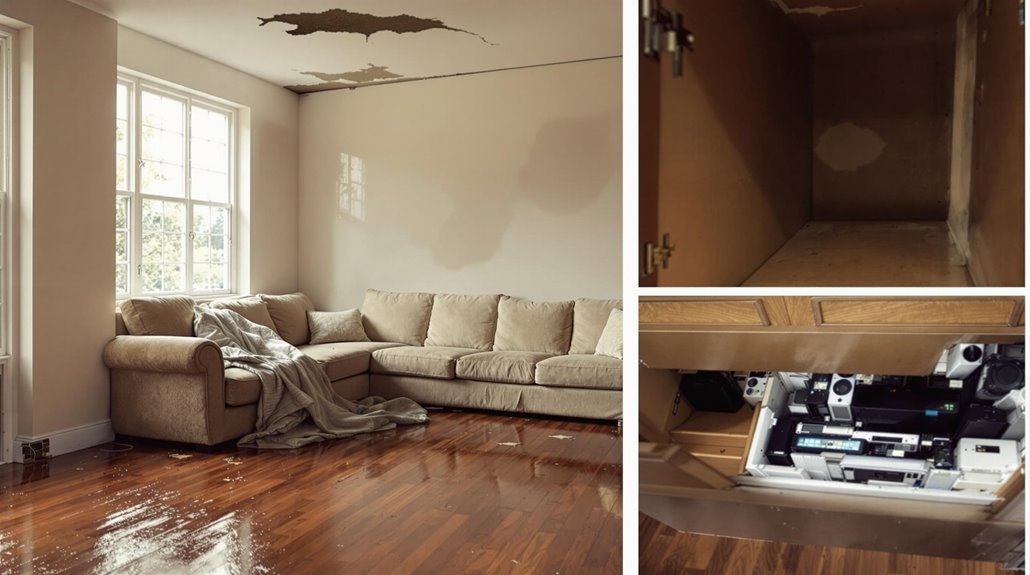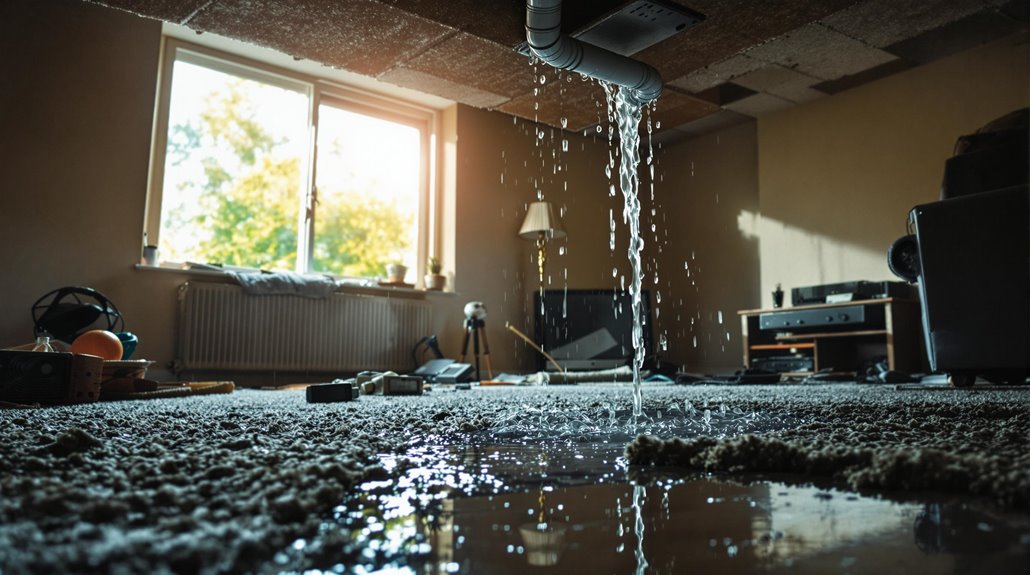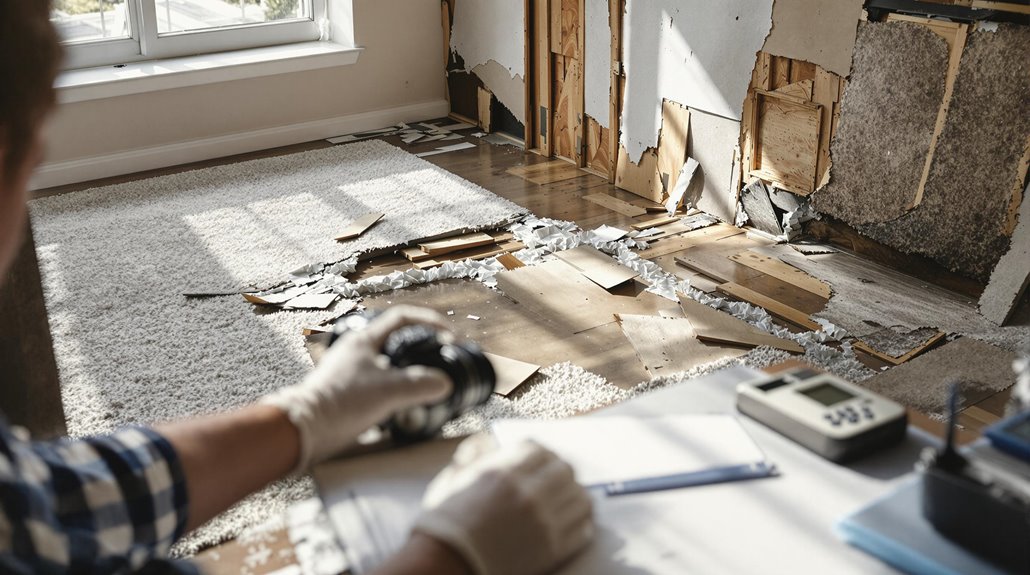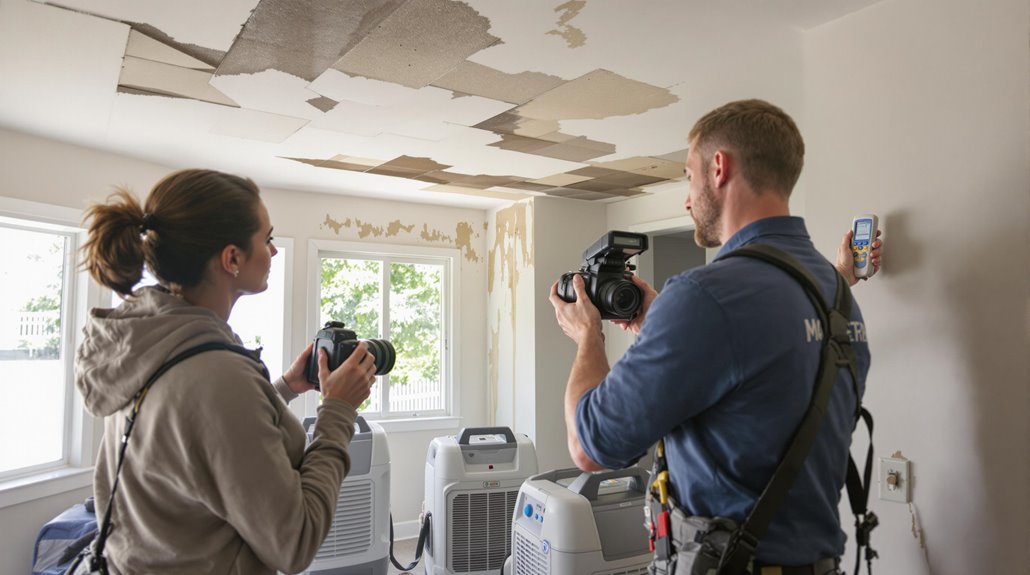Filing a water damage insurance claim requires immediate documentation and action. Homeowners must first guarantee safety by shutting off water and electricity, then photograph and video all damage before cleanup begins. A detailed inventory of affected items, including values and descriptions, strengthens the claim. Promptly notify the insurance company and maintain clear communication throughout the process. Working with public adjusters and restoration professionals can greatly increase claim settlements and guarantee proper compensation. Additionally, it is crucial to keep records of all communications with your insurance provider and any restorations made to the property. Consider researching guides on how to claim water damage costs, as they often provide valuable insights into maximizing your settlement. By remaining organized and proactive, homeowners can navigate the complexities of the insurance process with greater ease and confidence.
Key Takeaways
- Document all damage immediately with clear photos and videos, including close-ups of water marks and affected belongings.
- Contact your insurance company promptly to report the damage and begin the claims process.
- Create a detailed inventory of damaged items with descriptions, estimated values, and supporting documentation.
- Schedule an inspection with the insurance adjuster and prepare all evidence, repair estimates, and policy information.
- Consider hiring a public adjuster to navigate complex claims and potentially increase settlement amounts through professional negotiation.
Understanding Water Damage Coverage in Your Home Insurance Policy
When it comes to water damage coverage in home insurance policies, homeowners must understand exactly what their policy covers and excludes.
Standard policies typically cover sudden and accidental water damage from plumbing issues, burst pipes, and unexpected roof leaks. Coverage also extends to water damage caused by ice dams and vandalism.
One of the common water damage myths is that all types of water-related incidents are covered. However, significant coverage limitations exist. Standard policies exclude damage from floods, groundwater seepage, and sump pump failures unless additional coverage is purchased.
The cause of water damage must be sudden and accidental, not gradual or due to poor maintenance.
Insurance companies thoroughly investigate claims through adjusters to determine if the damage resulted from covered perils or negligence.
Homeowners can expand their protection by adding optional endorsements for flood insurance, mold coverage, sewer backup protection, and special personal property coverage.
Immediate Steps to Take After Discovering Water Damage

Upon discovering water damage in a home, residents must take swift and decisive action to guarantee safety and minimize property damage. The first priority is implementing immediate safety protocols, including shutting off water and electricity in affected areas while ensuring all household members are safe and accounted for.
The next vital step involves identifying and stopping the water source. Residents should inspect nearby areas for leaks, containing any visible water flow and shutting off the main water supply if necessary. If the source cannot be located, emergency contacts such as plumbers should be notified immediately.
Throughout this process, it is imperative to maintain water safety by avoiding contact with potentially contaminated water.
Simultaneously, homeowners should begin documenting the damage and contact their insurance provider to initiate the claims process. This includes reviewing the policy coverage, providing necessary information, and keeping detailed records of all temporary repairs and associated expenses for reimbursement purposes.
Documenting the Damage: Photos and Evidence Collection

Thorough documentation of water damage serves as the foundation for a successful insurance claim. The damage assessment process should begin with extensive wide-angle photographs showing the full extent of affected areas, followed by detailed close-ups of specific damage to structures and belongings.
Homeowners should capture both photos and video evidence of the water source and resulting destruction.
Evidence preservation requires creating a detailed inventory of damaged items, including descriptions and estimated values. Documentation should extend to hidden areas behind walls and inside cabinets where water damage may not be immediately visible.
All evidence should be organized in digital folders, categorized by room or area, and accompanied by a chronological log of events. It's essential to maintain all damaged items until an insurance adjuster completes their review, while storing salvageable belongings in a dry location.
Receipts for temporary repairs and related expenses should be carefully preserved throughout the claims process.
Working With Insurance Adjusters: What to Expect

Meeting with an insurance adjuster requires thorough preparation, including gathering all documented evidence of water damage, repair estimates, and relevant policy information.
The adjuster will examine the damage firsthand, review provided documentation, and may request additional information or clarification during the assessment process.
Property owners should maintain detailed records of all interactions with the adjuster and establish clear timelines for claim processing, follow-up communications, and expected settlement dates.
Initial Meeting Preparations
Successfully preparing for an insurance adjuster's visit requires careful organization and documentation of the water damage incident. Homeowners should ascertain all affected areas are accessible for inspection and compile a detailed timeline of events leading to the damage.
Proper claim documentation includes gathering receipts for emergency repairs and organizing contact information for any contractors involved.
Before the adjuster arrives, homeowners should review their insurance policy to understand coverage limits and deductibles. This knowledge facilitates effective adjuster communication during the assessment.
Having photographs of the damage, maintenance records, and a list of damaged items ready for review streamlines the inspection process. Additionally, preparing questions about the claims process and potential coverage implications helps homeowners make informed decisions during the initial meeting.
Documentation and Evidence Process
Working with insurance adjusters requires thorough documentation of water damage incidents. Effective evidence gathering includes detailed photographs of affected areas, damaged belongings, and the water source.
Homeowners should maintain detailed records of all correspondence with insurance agents, contractors, and restoration companies.
Documentation tips for a successful claim include creating a complete home inventory, collecting repair estimates from multiple contractors, and preserving physical evidence such as broken components from ruptured pipes or appliances.
Before and after photos establish the scope of damage, while measurements and written descriptions provide additional context.
Homeowners should organize receipts for out-of-pocket expenses related to cleanup and initial restoration services. This systematic approach to documentation strengthens the claim and facilitates the adjuster's assessment of the damage.
Timeline and Follow-up Steps
The timeline for a water damage insurance claim typically spans several weeks to months, depending on the severity of damage and complexity of repairs. Efficient claim processing relies heavily on clear communication between the homeowner and insurance adjuster throughout each phase.
- Initial assessment occurs within days, when an adjuster visits to document damage and collect evidence.
- Property drying and moisture removal takes approximately one week to complete.
- Estimation and funding decisions typically require 2-3 weeks for processing.
- Repair work scheduling and completion ranges from 1-3 weeks.
To expedite the process, homeowners should maintain regular contact with their adjuster, promptly provide requested documentation, and follow up on claim status updates.
Understanding policy terms and keeping detailed records of all communications helps facilitate smooth claim resolution.
Filing Your Claim: Step-by-Step Process

When filing a water damage claim, proper documentation through detailed photographs and written records forms the foundation for a successful claim process.
Homeowners should thoroughly capture images of all affected areas, damaged items, and the source of water intrusion before any cleanup begins.
Insurance companies require prompt notification of water damage incidents, so contacting the insurer should occur immediately after securing evidence and implementing initial damage control measures.
Document Everything First
Proper documentation serves as the foundation for a successful water damage insurance claim. Evidence gathering should begin immediately after discovering the damage, focusing on extensive claim documentation that includes photos, videos, and detailed records of all affected areas and items.
- Take clear, well-lit photographs of every damaged area, including close-ups of water marks, structural damage, and affected personal belongings.
- Record a thorough video walkthrough of the property, narrating the extent and nature of the damage.
- Create a detailed inventory list of damaged items, including their purchase date, original value, and current condition.
- Save all relevant receipts, including emergency repairs, temporary accommodations, and replacement purchases in both physical and digital formats.
Contact Insurance Right Away
Swift action in contacting your insurance company forms a critical first step after discovering water damage in your home. Timely reporting enhances the likelihood of claim approval and expedites the recovery process. When contacting the insurer, policyholders should have their policy number and detailed damage documentation readily available.
| Action | Required Information | Purpose |
|---|---|---|
| Initial Call | Policy Number, Date of Incident | Begin Claim Process |
| Damage Report | Photos, Description | Document Extent |
| Source Assessment | Cause of Damage, Location | Determine Coverage |
| Timeline Details | Discovery Time, Actions Taken | Support Claim |
The insurance company will assign an adjuster to evaluate the damage and determine coverage based on policy terms. During this contact phase, homeowners should inquire about immediate mitigation steps and whether to proceed with professional water damage restoration services.
Common Mistakes to Avoid When Filing Water Damage Claims

Filing a water damage insurance claim requires careful attention to detail and proper protocol to guarantee successful compensation. Common misconceptions about coverage and documentation often lead to claim denials or reduced settlements. Expert insights reveal that understanding policy terms and maintaining thorough records are essential for successful claims.
- Homeowners rushing to make permanent repairs before the adjuster's assessment, compromising their ability to demonstrate the full extent of damage.
- Property owners failing to capture extensive photo and video evidence, leaving them unable to prove pre-existing conditions.
- Claimants accepting initial settlement offers without proper evaluation, potentially missing coverage for hidden moisture damage.
- Residents neglecting to maintain detailed communication records with insurers and contractors, hindering their ability to track claim progress.
Avoiding these vital mistakes requires understanding policy coverage limits, maintaining accurate documentation, and following proper claim procedures.
Success depends on prompt reporting, thorough evidence collection, and professional damage assessment.
Getting Professional Help for Water Damage Restoration

When water damage strikes a property, securing professional restoration services becomes a critical first step toward recovery and proper claims documentation.
Professional teams equipped with advanced restoration technology can quickly assess damage extent, extract water, and implement effective water damage prevention measures. Their immediate response helps minimize secondary issues like mold growth and structural deterioration.
Selecting a reliable restoration company requires careful consideration of their credentials, experience, and service availability. Property owners should seek companies offering 24/7 emergency response, all-encompassing restoration services, and expertise in insurance claim documentation.
The best providers utilize state-of-the-art equipment for moisture detection and structural drying, while maintaining detailed records throughout the restoration process.
Professional restoration services not only accelerate recovery but also strengthen insurance claims through thorough documentation, including photographs, damage assessments, and detailed repair records.
Their expertise guarantees proper handling of both visible and hidden water damage, ultimately supporting a successful claims process.
The Benefits Of Consulting A Public Adjuster

Consulting a public adjuster provides valuable expertise in maneuvering complex water damage insurance claims and guarantees objective assessment of the damage without emotional bias.
Public adjusters streamline the claims process by managing all documentation, correspondence, and negotiations with insurance companies while representing the homeowner's best interests.
Studies indicate that homeowners who work with public adjusters receive notably higher claim settlements, with payouts averaging $22,266 compared to $18,659 without professional representation.
Expertise In Insurance Claims
Many homeowners overwhelmed by water damage claims can benefit greatly from a public adjuster's expertise in insurance matters.
These professionals possess deep knowledge of insurance policy nuances and claim documentation strategies that prove invaluable during the claims process. Their specialized understanding enables them to interpret complex policy language and identify all available coverage benefits.
- Reviews insurance policies line by line to uncover hidden coverage opportunities
- Documents water damage thoroughly with detailed photographs and reports
- Prepares extensive estimates that account for both visible and hidden damage
- Maintains organized claim files with supporting evidence for each damage item
Public adjusters apply their expertise to make certain claims are properly documented, accurately valued, and submitted in compliance with policy requirements.
This greatly improves the likelihood of a favorable settlement for the policyholder.
Objective Damage Assessment
An objective assessment of water damage stands as one of the primary advantages of working with a public adjuster. Through their unbiased evaluation, these professionals conduct extensive inspections that identify both obvious and hidden water damage throughout the property.
Their detailed documentation typically results in settlement increases of up to 20% compared to self-filed claims.
Public adjusters meticulously examine all affected areas, creating thorough damage reports that account for immediate and potential long-term issues caused by water intrusion.
Their systematic approach guarantees that no damage goes unnoticed or undocumented. By leveraging their expertise in insurance policies, they can identify all applicable coverage benefits and compile evidence that supports maximum claim value, providing insurance companies with detailed documentation that substantiates the full extent of the damage.
Streamlined Claim Process
The decision to hire a public adjuster greatly streamlines the water damage claims process while reducing stress for homeowners. Through efficient claims management, public adjusters handle all aspects of documentation, communication, and negotiation with insurance companies. Their claims assistance services include thorough damage assessments and extensive claim preparation, ensuring nothing is overlooked.
- Professional adjusters gather and organize all required documentation, from initial damage photos to repair estimates.
- They coordinate directly with contractors and insurance representatives, eliminating communication bottlenecks.
- Adjusters manage deadlines and paperwork submissions, preventing costly delays.
- They prepare detailed damage inventories and cost assessments to support maximum claim settlements.
Working on a contingency fee basis, public adjusters provide expert representation without requiring upfront payment, advocating exclusively for the homeowner's interests throughout the claims process.
Higher Claim Payouts & Settlements
Statistical evidence demonstrates that homeowners who engage public adjusters typically receive substantially higher insurance settlements for water damage claims.
Studies show claims handled by public adjusters average $22,266 compared to $18,659 without professional representation, highlighting significant public adjuster advantages in maximizing compensation.
These specialists excel at identifying all water damage insurance claim components that might otherwise be overlooked. Their expertise in policy interpretation and damage assessment guarantees detailed documentation of losses.
Working on a contingency basis, public adjusters are incentivized to secure maximum settlements, as their compensation directly correlates with the claim amount. Their professional negotiation skills and thorough documentation methods help substantiate higher claim values, while their emotional detachment from the situation enables more effective negotiations with insurance companies.
About The Public Claims Adjusters Network (PCAN)

Professional public claims adjusters form an essential network of independent advocates who work exclusively for policyholders during insurance claims processes.
The Public Claims Adjusters Network (PCAN) consists of licensed professionals who collaborate to provide thorough claim management services across multiple regions, sharing expertise and resources to benefit policyholders.
These specialized claims network members offer:
- Expert policy interpretation and damage assessment capabilities
- Coordinated communication management with insurers, contractors, and witnesses
- Strategic negotiation services to maximize settlement outcomes
- Remote and in-person claim handling options for convenience
PCAN members maintain strict adherence to state-specific fee regulations while delivering high-quality service.
Their combined experience in both residential and commercial claims allows for effective handling of complex insurance matters, including multi-layer coverage scenarios and accurate property valuations.
This network approach guarantees policyholders receive consistent, professional representation regardless of claim location or complexity.
Frequently Asked Questions
How Long Does Mold Typically Take to Develop After Water Damage Occurs?
In damp, dark conditions, mold growth begins within 24-48 hours after water damage occurs. Visible colonies form within 3-12 days, with extensive spread occurring beyond 12 days without proper prevention tips.
Can I Switch Insurance Companies While a Water Damage Claim Is Pending?
Policyholders can legally switch insurance providers while a water damage claim is pending. The original insurer remains responsible for processing the existing claim, though finding new coverage may present challenges.
Will Filing Multiple Water Damage Claims Increase My Future Insurance Premiums?
Like ripples expanding in a pond, multiple water damage claims create lasting effects. Insurance companies view claim frequency as a risk indicator, typically resulting in significant premium increases or potential coverage loss.
Does Homeowners Insurance Cover Temporary Housing During Water Damage Repairs?
Homeowners insurance typically covers temporary housing options during water damage repairs when the home is deemed uninhabitable. Coverage details vary by policy and may include hotels, rental homes, and additional living expenses.
Can I Choose My Own Contractor, or Must I Use the Insurer's Recommendations?
Policyholders maintain the right to select their own contractors during the claim process. While insurance companies may recommend contractors, using these suggestions is optional and not mandatory for claim approval.








